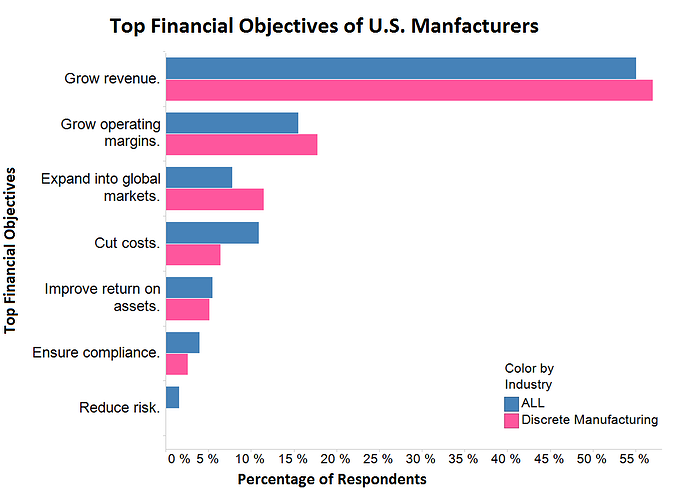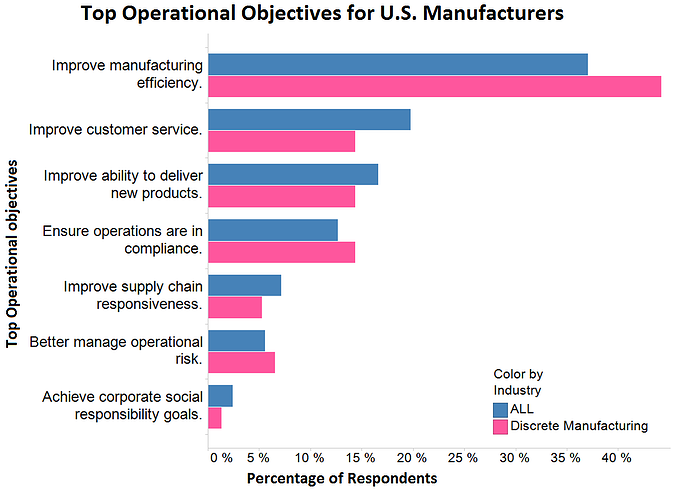For obvious reasons, most companies have a central focus on growth. The more sales closed, in combination with improvements to operating margins, the better. As a manufacturer, you have control over a variety of the operational aspects of this strategy and can employ process improvements, technology, and metrics to help deliver these results.
Though, with pressures to grow from top-level management and external stakeholders, it’s common and, in many respects, easier in the short term for manufacturers to focus on cost-cutting methods rather than taking a holistic, long-term approach to improving products and processes for sustained growth.
This post intends to highlight the challenges with focusing on these immediate benefits, and how a comprehensive platform approach to manufacturing operations can enable far greater results.
Understanding the Drivers Behind Strategic Decisions
LNS Research’s 2012-2013 Quality Management Survey puts these concepts into focus. When we look at the top financial and operational objectives noted by over 500 industry executives in comparison to only those executives in U.S. discrete manufacturing industries, we see two main points stand out.

Financially, a majority of companies in all industries and U.S. discrete manufacturing industries specifically are putting efforts into growing revenue, with only a fraction of that focus on growing and improving operating margins. As it pertains to financial objectives, the numbers seem to taper off with less respondents reporting objectives around expanding into global markets and ensuring compliance.

Operationally, most companies across all industries are focused on improving manufacturing efficiency, and that number is even greater when we account for just U.S. discrete manufacturers. Other operational areas such as improving supply chain responsiveness, managing compliance, and introducing and delivering new products seem to take a backseat to manufacturing efficiency. Therefore, the need to improve manufacturing processes for efficiency is being seen as a key to supporting sustained growth objectives. A manufacturing organization that is more efficient can truly "do more with less" and rapidly react and respond to growth challenges.
Bridging the Gap Between Financial and Operational Objectives
In contrast to focusing primarily on cutting costs to realize growth, there are a number of strategies that market leading discrete manufacturers are leveraging to actually enable long-term growth and movement toward operational goals. Specifically, LNS has identified two key areas:
Establishing metrics and focusing on how they connect across the entire value chain: To realize strategic and recurring growth, it’s important to focus on metrics that provide an accurate and comparative measure of the efforts of people, processes, and technology over functional areas.
When used correctly, these metrics can show a global view of performance, which can be inspected and acted upon at a very granular level, and then further analyzed to identify areas for improvement. Metrics to include in this list are:
Focusing on how plant operations can drive growth with end-to-end business processes: There has to be the right mixture of people, processes, and technology to support growth when using these manufacturing KPIs. A facilitating attribute of many leading manufacturers is having a robust and seamless IT architecture that connects data sources and processes across the value chain, and then organizes them into actionable information and repeatable workflows.
Companies should be putting efforts into creating a more collaborative and streamlined supply chain, improving the new product introduction process, standardizing manufacturing production processes and metrics across lines and plants, and establishing closed loop quality management processes to help identify nonconformances closer to product design rather than the customer.
Realizing End-to-End Visibility with the Right IT Architecture
A major roadblock for driving growth through end-to-end, business, and manufacturing processes can be found in many manufacturing facilities’ fragmented, database-centric IT architectures. It’s common for there to be hundreds of manufacturing software applications and solutions that aim to solve a series of point issues and don’t effectively communicate with one another.
This lapse in manufacturing operations communication is expected to slowly become an issue of the past, as manufacturers work to consolidate and simplify solutions portfolios. LNS Research has recently been discussing this topic, and the market space’s movement toward a comprehensive manufacturing operations platform approach.
Having the capability to manage operations using these types of modern platforms and 'apps' will create a range of strategic growth opportunities that span far beyond cost cutting. Manufacturers will have the ability to better manage end-to-end, business and manufacturing processes, which will deliver compounding impacts to profitability, reputation, the quality of products, and overall business performance.
A Deeper Look into Growth and Profitability in Manufacturing
At 1:00 pm tomorrow, June 20, LNS’s President and Principal Analyst, Matthew Littlefield, will be participating in a webcast on this topic. He will be joined by Melissa Cook, Senior Director and Global Manufacturing Industries Lead for Microsoft Dynamics and Gil Garcia, Director of Manufacturing Industries at U.S. Dynamics.
The webcast will highlight global manufacturing trends and discuss the role that technology can play in driving growth and profitability in the manufacturing sector. Sign up today!

You might also be interested in:
9 Uses for Enterprise IT and MOM Software in Manufacturing
Top 6 Challenges in Electronics Manufacturing
Manufacturing Metrics: First Pass Yield Benchmark Data